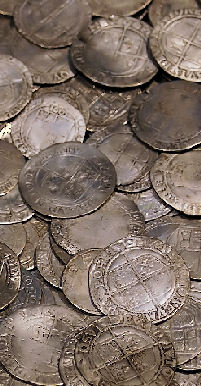
● Next Meeting Status:
Cancelled

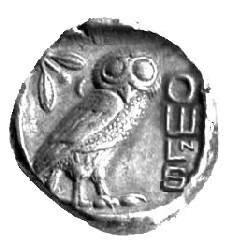

● Host Society for the
BANS 2011 Congress
held in Southport


Merchant Countermarked Dollars
Merchant Countermarked Dollars of the Late 18th & Early 19th Centuries.
Eric C Hodge
During the latter half of the eighteenth century, fluctuations in the gold-

It was not that there was a shortage of silver, far from it. There were plenty of
Spanish American silver dollar sized coins available as bullion. The lack of coins
in Great Britain was solely due to the inability of the Royal Mint to afford the
purchase of silver for recoinage. By an order issued in 1601, the Mint could only
purchase silver at 5s 2d an ounce, generally below the current market price in the
mid to late 18th century. Finally the New Coinage of crowns to sixpences, initiated
in 1816-
The earliest and longest-

Problems for the issuers arose when the market price fluctuated by more than a few pence. A drop would bring on a flood of demands for redemption of the tokens at their countermarked value. A significant rise would mean the countermarked tokens could be sold, more profitably, back into the bullion market. In either case, the issuer would not want to reissue redeemed tokens at their original countermarked valuation.
One solution was melting, another was to repunch a revised value on the coin (Figs 1 & 9) and a further option was to cancel the coin countermarked value and issuer’s name, with either a grille pattern or by individual punch marks. (Fig 2)
The need for an increased supply of silver coinage was exacerbated by the Industrial Revolution. The workers had to be paid. Initially this could be in kind, but this created extra burdens on the employers. Much better to pay in cash, and let the workers fend for themselves. Slowly the idea of works’ shops was implemented, first to make extra money from the workers, but latterly as a genuine attempt by philanthropic leaders of industry to improve the lot of the lower classes.
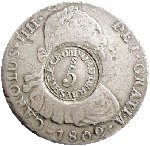
Fig 1
Cromford Obverse
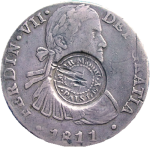
Fig 2
Muir Obverse
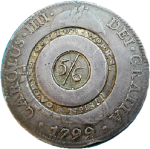
Fig 9
Catrine Obverse
Hover your cursor to
see the coins in detail

Production of one’s own currency, therefore, had its benefits. One could either tie the worker to one’s own shop, or conversely give additional benefits to the employee who used the works’ facilities. The countermarked dollars did both. They had their own intrinsic value in the silver, and also a higher value marked on them for use at the works, or as commonly became standard, in the surrounding community that survived from, and supported, local business.
The most prolific issues came from Scotland. Of the approximately seventy known business issuers of countermarked dollars, over 85% were in Scotland, one quarter being in the cotton trade. Of the remaining, known, Scottish countermarked dollars, over 50% are from the cotton trade. Why was this?
There is no definitive answer to this question because there are so few records about countermarked dollars and also about the businesses that issued them. However the answer seems to lie in a mix of: distance from London, so even fewer silver coins from an already short supply; a desire to retain labour attracted from the Highlands or agriculture in general, to factory conditions; a ready supply of dollars, perhaps from the tobacco and other trades to America and the Caribbean developed from Glasgow; some of the larger issuing businesses being controlled by the same family, the Finlays; a realisation how effective these issues were, coupled with the difficulty of the Government in London to exercise its legislative powers in Scotland; the slower use of steam power driving the cotton factories into the city.

In England, it was the use of steam power, over water power, that gave rise to the enormous growth of the cotton trade in Manchester which, using its own banking system and paper money, precluded the necessity of countermarked dollars. No issuers are known for Manchester.
The remaining issuers were mainly grocers and other merchant traders, and some banking concerns. The merchant traders would, of course, benefit greatly from their ability to give change for gold, where this was offered, ensuring continued future trade.
Of the six recorded English issuers, three were in the cotton trade: Revolution Mill, Cromford Mill and Cark Cotton Works.
The Revolution Mill countermark is purely an ampersand with a crown above it. (Fig 3) There is no mark of value and no indication of the issuer. The details would have probably remained unknown, were it not for Sarah Sophia Banks, (sister of Sir Joseph Banks), whose collection of coins was bequeathed to the British Museum, together with note books and manuscripts detailing the coins and their sources. Under the details of the Ampersand & Crown was written ‘Spanish dollar stamped for circulation at the Revolution Mill in East Retford Notts 1794’, 1794 being the date she acquired it.
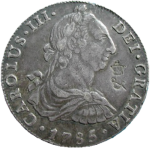
Fig 3
Revolution Obverse

An additional facet to the collecting of this series is, due to the lack of contemporary
records, it is not possible to assert what is genuine and what is not. Experience
counts for a lot but also provenance is very important in ascertaining how long certain
marks have been known. Revolution Mill provides a perfect example. About ten genuine
countermarks are known, (per the Bank’s example), punched in front of the bust. There
are, however, three ‘counterfeits’ known with a similar stamp, but much thicker and
heavier-
Another English countermark is from Cromford in Derbyshire. (Fig 1A enlarged from
Fig 1). Sir Richard Arkwright was an influential figure in the development of the
English cotton spinning industry. Not only did the Arkwrights build the mill at Cromford,
but they also built the town to accommodate their workers. The surviving countermarks
are of two valuations of 4/9 and 5/-
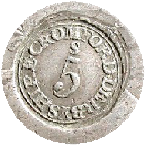
Fig 1A
Cromford Countermark

Another English cotton issue is that from the Cark Cotton Works. (Figs 4 & 5) This is an unusual issue as the obverse of the coin has the business name, whereas the reverse of the coin has the issue value, in words and not numbers, which would tend to indicate an early issue date when new ideas were being tested. Cark is a small village near Cartmel in the southern Lake District. There are eleven tokens known, all to the value of 4/6. The obverse countermark reads Cark Cotton Works 1787, and as ten of the tokens are dated 1785 and earlier, with the eleventh dated 1792, it would tend to confirm an early issue up to the mid 1790’s. It is presumed that 1787 is the date the tokens were first issued.

We now travel to Scotland to look at a selection of the tokens issued by the burgeoning industrial concerns around Glasgow. One of the biggest of these businesses was the Lanark Mills situated 25 miles south east of Glasgow. New Lanark was a completely new and self contained village. In the 1780’s Arkwright visited Scotland and teamed up with David Dale, a Scottish banker, to build the Lanark Mills, using Arkwright’s patents and Dale’s money.
The Lanark Mills countermarked tokens are the most prolific in the entire merchant
series. (Fig 6) They are known for values of 5/-
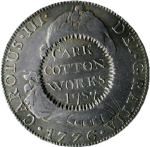
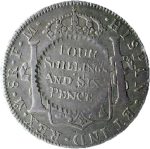
Fig 5
Cark Reverse
Fig 4
Cark Obverse
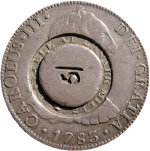
Fig 6
Lanark Obverse

The Industrial Revolution was fuelled by a number of factors, but it was oiled with money. Banks and finance were important ingredients in the overall mix that increased the wealth of the businessmen and owners of the industrial concerns. So it is no surprise to find that two banks issued merchant countermarked dollars, the Thistle Bank and the Glasgow Bank.
The Thistle Bank countermarked dollars are known in three values, 4/9, 5/-

There were many other concerns involved with all aspects of cotton spinning and weaving
and one of the most interesting, when looked at from the angle of countermarked dollars,
is the Catrine Cotton Works. Catrine was owned by the Finlay family as was Deanston
Cotton Mill and Ballindalloch Cotton Works, both countermarked dollar issuers. Catrine
had a variety of values being 6/6, 5/6, 5/-
The estimated order of issue of the countermarks is 4/9, 5/6 punched over 4/9, 5/-
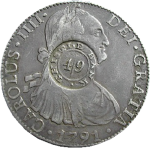
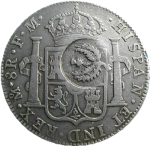
Fig 8
Thistle Bank Reverse
Fig 7
Thistle Bank Obverse

Fig 9
Catrine Obverse

Fig 9A
Catrine Serial Number

Another Scottish cotton concern that issued countermarked dollars was the Rothsay Cotton Works. Rothsay lies about forty miles southwest of Glasgow at the head of a bay on the Island of Bute.
The Rothsay Mills tokens are quite varied and unusually this was the only concern
that countermarked cut Spanish dollars to the values of 2/6, 2/4 and 1/8. (Fig 10)
The dollars were marked in two denominations of 5/-
Only one of the 5/-
Fig 12
Rothsay Reverse

Fig 11
Rothsay Obverse
Fig 10
Rothsay Cut Piece
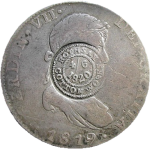
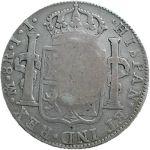

Another countermark, using both an obverse and a reverse mark, was that for J. Muir,
manufacturer, Paisley. (Fig 2) The reverse mark was the Prince of Wales feathers
bearing the motto 'Ich Dien' (Fig 13) With such a common Scottish name, it is difficult
to allocate this mark with ease. It is currently linked to a family who worked as
plaid merchants and shawl and muslin manufacturers. Maybe the reverse mark of the
Prince of Wales feathers was somehow linked to the designs used in the plaid or shawl
businesses. There are about nineteen of these coins known and at least nine of them
have been cancelled, but with different cancellation marks. Some are cancelled with
a grille pattern, whilst others are marked with digs or controlled pear-

Fig 2
Muir Obverse
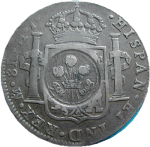
Fig 13
Muir Reverse

Another issuer is the firm of McFie Lindsay & Co. Greenock, listed as being in the
wholesale grocery trade between 1815 and 1834. One of their tokens is severely double-

In this short article we have touched only the surface of this fascinating subject. There is so much research still to do that the rarity of the coins themselves is of secondary importance to the seeking of information. A dream subject for the economic and social historian, the tokens constituted a vital link between the industrialists and the local communities in which they operated and also that they served. It required a set of most unusual circumstances for them to exist. These, in turn, allowed the countermarked coins to flourish. It required war, it required inventions, it required raw materials, it required men of vision, it required great markets, it required large labour forces, but most of all and truly most bizarrely, it required the inability of the Royal Mint to coin silver. Upon such small matters can history be made.
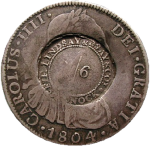
Fig 14
McFie Obverse

Further reading:
Tokens of the Industrial Revolution -
By Harrington E. Manville. Published by Spink, 2001.
Articles by the Author in Spink Numismatic Circular for January 1979, March 1980, October 1986, April 2001, June 2002, February 2005, April 2005, June 2006, October 2006, April 2007, October 2007, December 2007, December 2009 and September 2010.
Article by the Author in the British Numismatic Journal, vol 79, 2009

Where to next?
This paper was written in
December 2005
